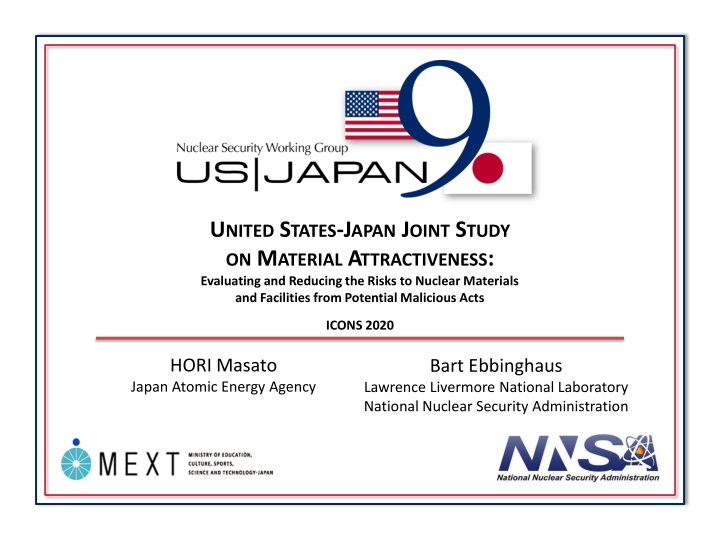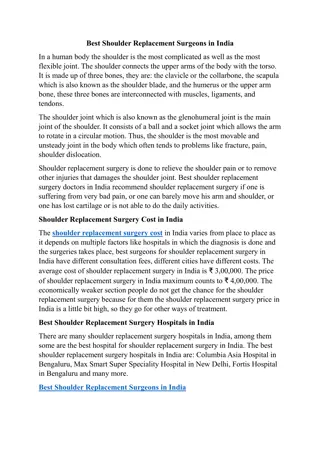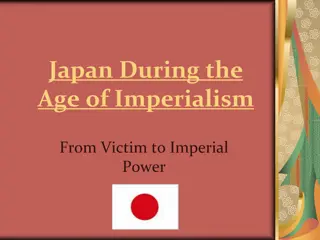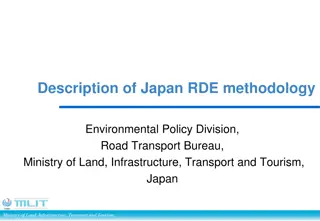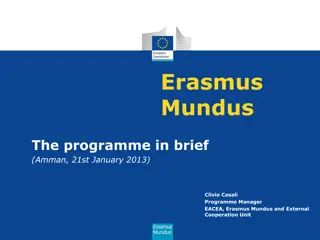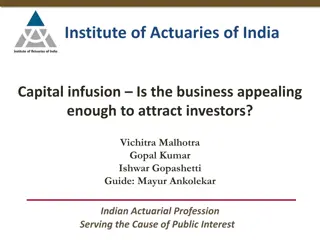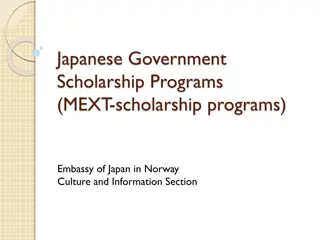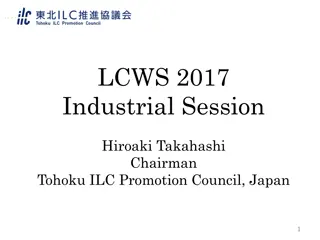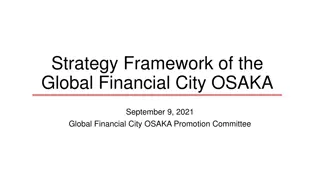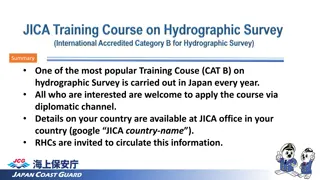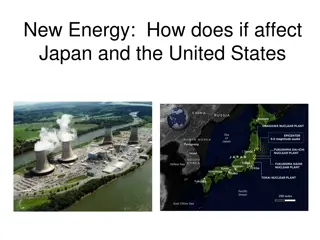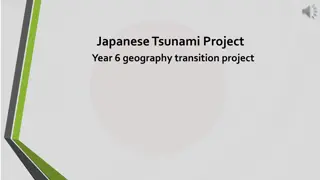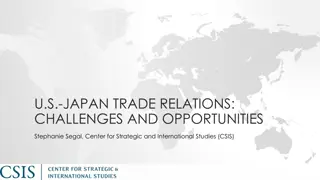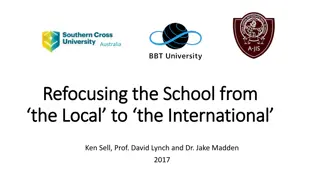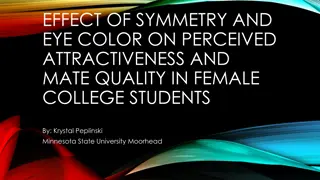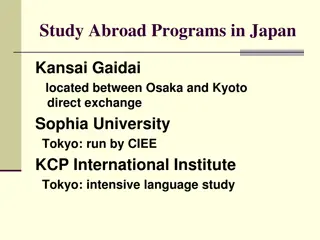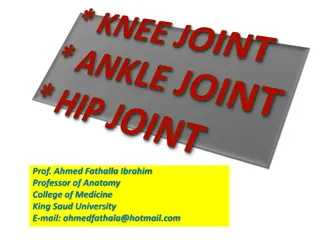United States-Japan Joint Study on Material Attractiveness
This collaborative study between the United States and Japan aims to evaluate and reduce the risks associated with nuclear materials and facilities being targeted for malicious acts. The focus is on assessing the attractiveness of nuclear materials for theft and misuse, as well as susceptibility of facilities to sabotage. By developing methodologies and prioritizing security-related research, the goal is to enhance the responsible security and storage of nuclear and radiological materials globally.
Uploaded on Oct 02, 2024 | 0 Views
Download Presentation

Please find below an Image/Link to download the presentation.
The content on the website is provided AS IS for your information and personal use only. It may not be sold, licensed, or shared on other websites without obtaining consent from the author.If you encounter any issues during the download, it is possible that the publisher has removed the file from their server.
You are allowed to download the files provided on this website for personal or commercial use, subject to the condition that they are used lawfully. All files are the property of their respective owners.
The content on the website is provided AS IS for your information and personal use only. It may not be sold, licensed, or shared on other websites without obtaining consent from the author.
E N D
Presentation Transcript
UNITED STATES-JAPAN JOINT STUDY ON MATERIAL ATTRACTIVENESS: Evaluating and Reducing the Risks to Nuclear Materials and Facilities from Potential Malicious Acts ICONS 2020 HORI Masato Japan Atomic Energy Agency Bart Ebbinghaus Lawrence Livermore National Laboratory National Nuclear Security Administration Goal 9: Reducing Material Attractiveness
Study Background The United States and Japan share a common obligation to ensure that their nuclear facilities do not become the source of materials used in a terrorist nuclear or radiological attack. Furthermore, both countries share a responsibility to help set the global standard for responsible security and storage of nuclear and radiological materials as leaders in the international civil nuclear energy sector. To achieve these goals, the two countries collaborate on analyzing the technical aspects of nuclear and radiological risk* under "Goal 9" of the United States-Japan Nuclear Security working Group (NSWG). * Risk is herein defined as the probability of non-state actors conducting malicious acts involving nuclear and radiological materials and facilities, multiplied by the consequence of the malicious act. Goal 9: Reducing Material Attractiveness 2 Nuclear Security Working Group
Goals for "Part A" of the Study Conduct a study that applies and expands on the conclusions of a 2012 joint study of material attractiveness. Jointly develop a methodology to evaluate attractiveness of fuel cycle materials for theft and use by non-state actors in nuclear and radiological malicious acts, and separately, the susceptibility of fuel cycle facilities to acts of sabotage. Develop an extension of the International Nuclear and Radiological Event Scale (INES) for assessing the consequence of each malicious act under consideration. Apply that methodology to various materials, processes, systems, and facilities within typical nuclear fuel cycles. Leverage results of the study to prioritize, by risk, security-related research and development activities and inform the improvement and optimization of security systems across the fuel cycle. Goal 9: Reducing Material Attractiveness 3 Nuclear Security Working Group
Study Progress The United States and Japan have identified a list of fuel cycle materials and facilities for analysis, prioritizing present day fuel cycles. Key: Goal 9: Reducing Material Attractiveness 4 Nuclear Security Working Group
Malicious Acts This study has expanded the spectrum of malicious acts to be examined beyond the single case in the 2012 study. Malicious Act Theft Sabotage Natural Groupings Nuclear Nuclear Radiological Radiological Nuclear Explosive Device (NED) Contamination Food and Water (CFW) Dispersal by Equipment Failure (RD-EF) Dispersal by External Means (RD-DbE) Radiation Exposure Outside Facility (RE-OF) Radiological Dispersal Device with Explosive (RDD-Ex) Radiological Dispersal Device without Explosive (RDD-nEx) Uncontrolled Exposure to Radioactive Materials (RE-UE) Criticality Device (CD) Uncontrolled Criticality (RE-UC) Previous Study Goal 9: Reducing Material Attractiveness 5 Nuclear Security Working Group
Assumed Adversary Three types of adversaries are being considered to cover a wide range of possibilities. Case 1: single individual, Case 2: sub-state group, and Case 3: near state-level group The attributes and characteristics for each case were derived consistent with IAEA Nuclear Security Series No. 10, "Development, Use and Maintenance of the Design Basis Threat". Willingness to put one s own life at risk; Intentions: sabotage, theft, public panic and social disruption, political instability, mass injuries and casualties; Group size; Weapons; Explosives; Modes of transportation; Technical skills; Insider threat issues; and Tactics Goal 9: Reducing Material Attractiveness 6 Nuclear Security Working Group
Phases The technical difficulties associated with a successful adversary attack and theft were evaluated based on relevant material properties during three different phases: Acquisition phase to remove nuclear material from a facility and transport it to the adversary s facility for processing. Processing phase to transform the nuclear material from its initial form into the final form for its intended use. This phase includes chemical processing such as purification, concentration and/or conversion to the final form. Utilization phase to build a threat device with the processed nuclear material, to transport it to the location of its intended use, and to use it. Sabotage malicious acts are still being studied separately Goal 9: Reducing Material Attractiveness 7 Nuclear Security Working Group
Metrics and Breakpoints The United States and Japan are nearing consensus on metrics (material properties) that reflect the attractiveness of materials for the malicious acts of theft of nuclear and radiological material. Each metric independently increases the technical difficulty for the adversary based upon its relevant material properties. Breakpoints, to determine the "bins" of material-attractiveness scoring for each metric, were defined quantitatively whenever possible. Phase Metric Gross weight Radiation dose Complexity BCM-metal (NED) BCM-solution (CD) Heat content Radiation dose Unit of measure kg Gy/h Descriptive kg kg W Gy/h Comment Acquisition Processing NED only CD only NED only Utilization Goal 9: Reducing Material Attractiveness 8 Nuclear Security Working Group
Future Work This joint study will continue for two-to-three years to develop methodologies for evaluating attractiveness as it applies to acts of sabotage, to evaluate the consequences of malicious acts, and to evaluate the overall risk. The overall methodology will be validated using generic facility models. The validated methodology will be used to evaluate concepts for proactively reducing risk (Part B). The final results will be presented at relevant academic meetings. Plans to hold a stakeholder workshop to share the study s results are also being considered. Goal 9: Reducing Material Attractiveness 9 Nuclear Security Working Group
Acknowledgements This study is being performed at the request of the United States Department of Energy/National Nuclear Security Administration and the Japanese Ministry of Education, Culture, Sports, Science, and Technology. The entire Goal-9 team has contributed greatly to the content of this paper and to the study s significant progress. The Japanese team consists of Y, Ban, T. Kimura, Y. Kimura, T. Nakatani, A. Oizumi, H. Sagara, T. Shiba, K. Suda, M. Tazaki, H. Tomikawa, together with the co- chair Masato Hori. The U.S. team consists of C. Bathke, B. Ebbinghaus, M. Robel, B. Rooney, S. Vessard, R. Bratton, R. Chamberlin, M. Ruch, F. Morris, B. Cowell, J. Wells, F. Frederick, A. St. Denis, together with the co-chair Chris Behan. The contribution of these many experts are gratefully acknowledged by the authors. Goal 9: Reducing Material Attractiveness 10 Nuclear Security Working Group
